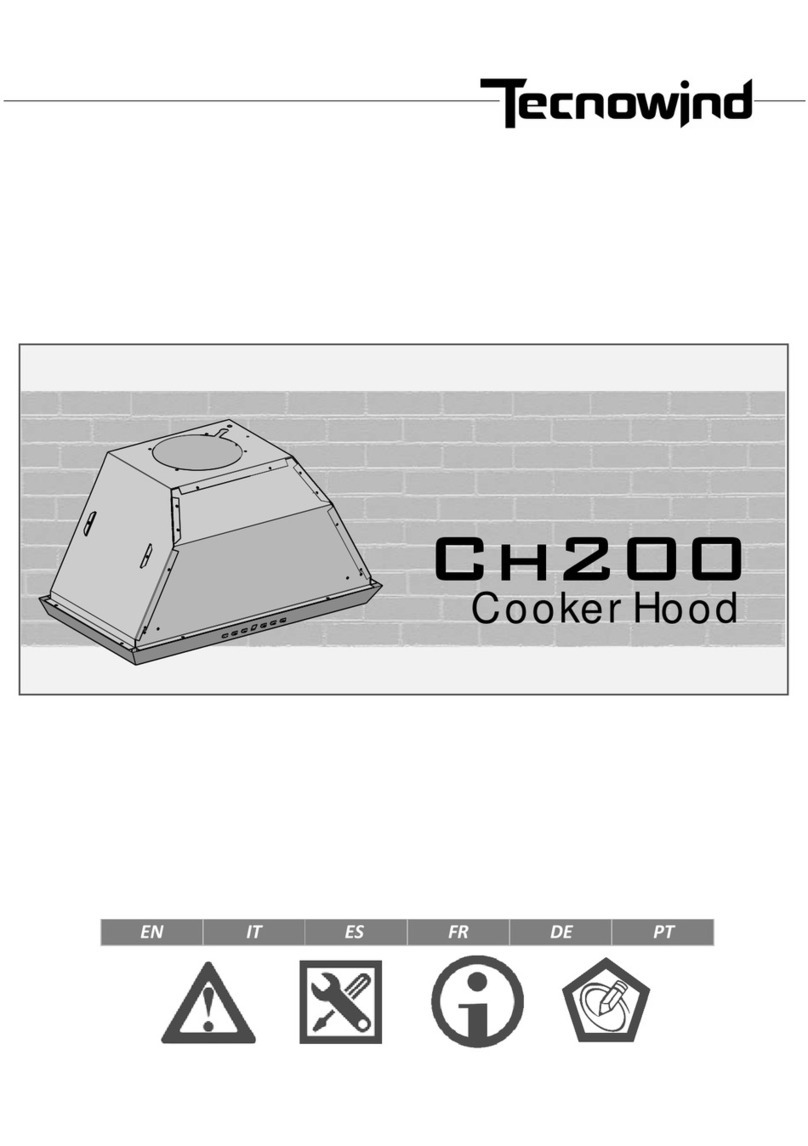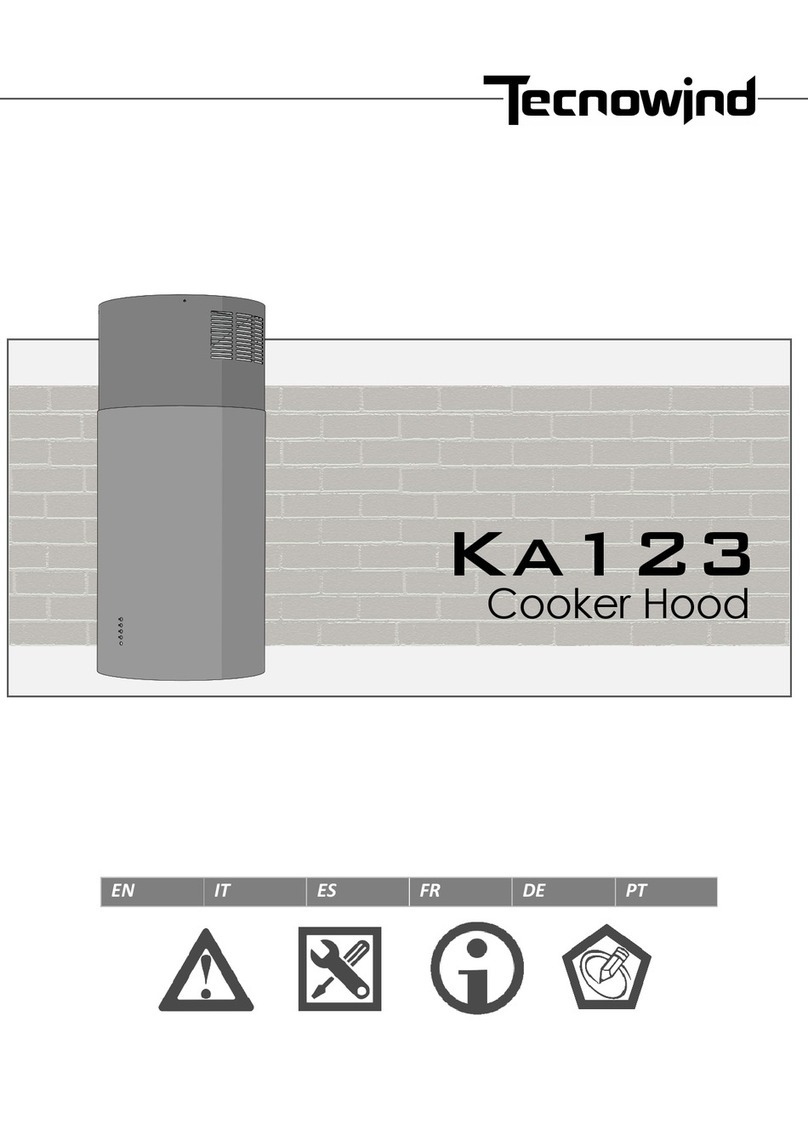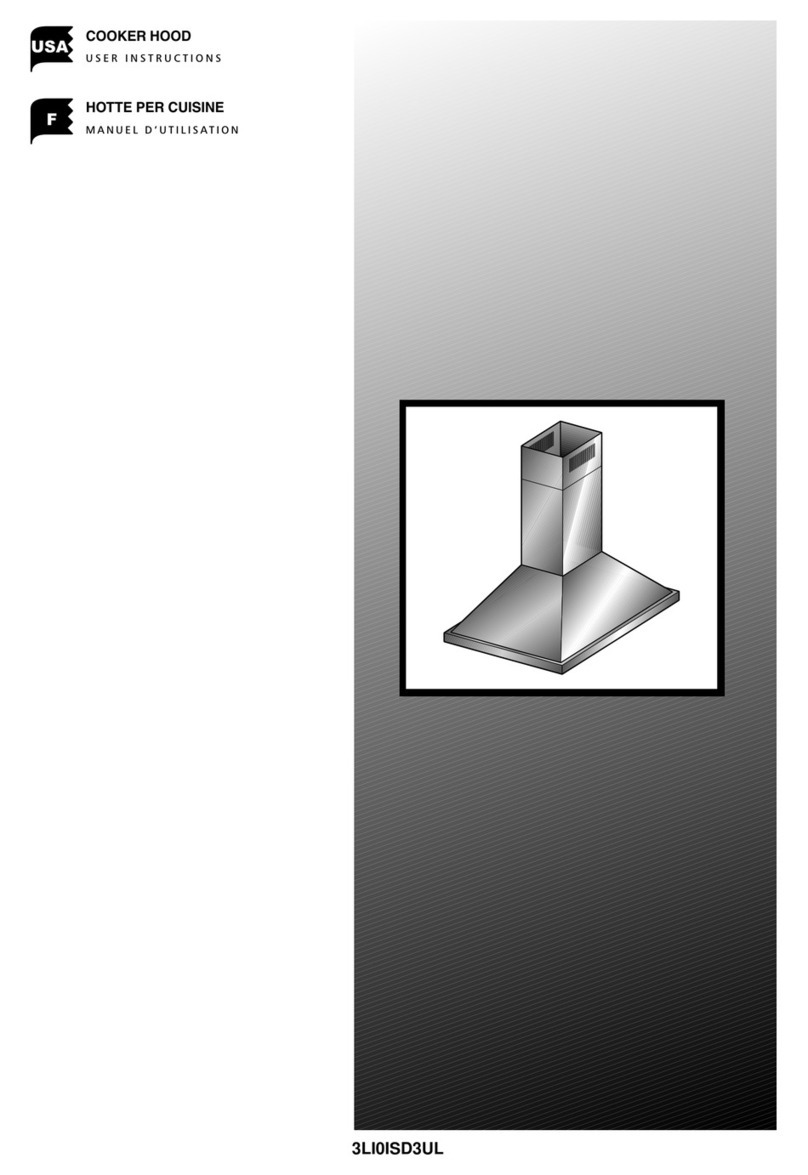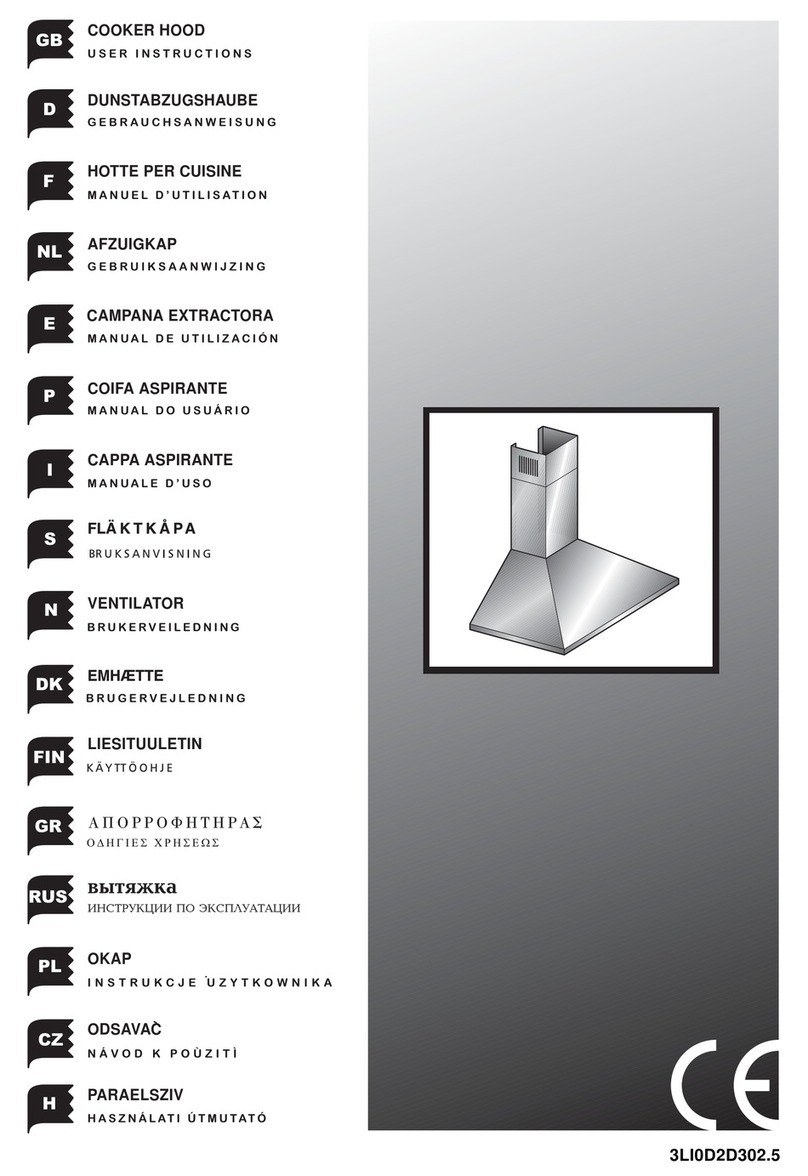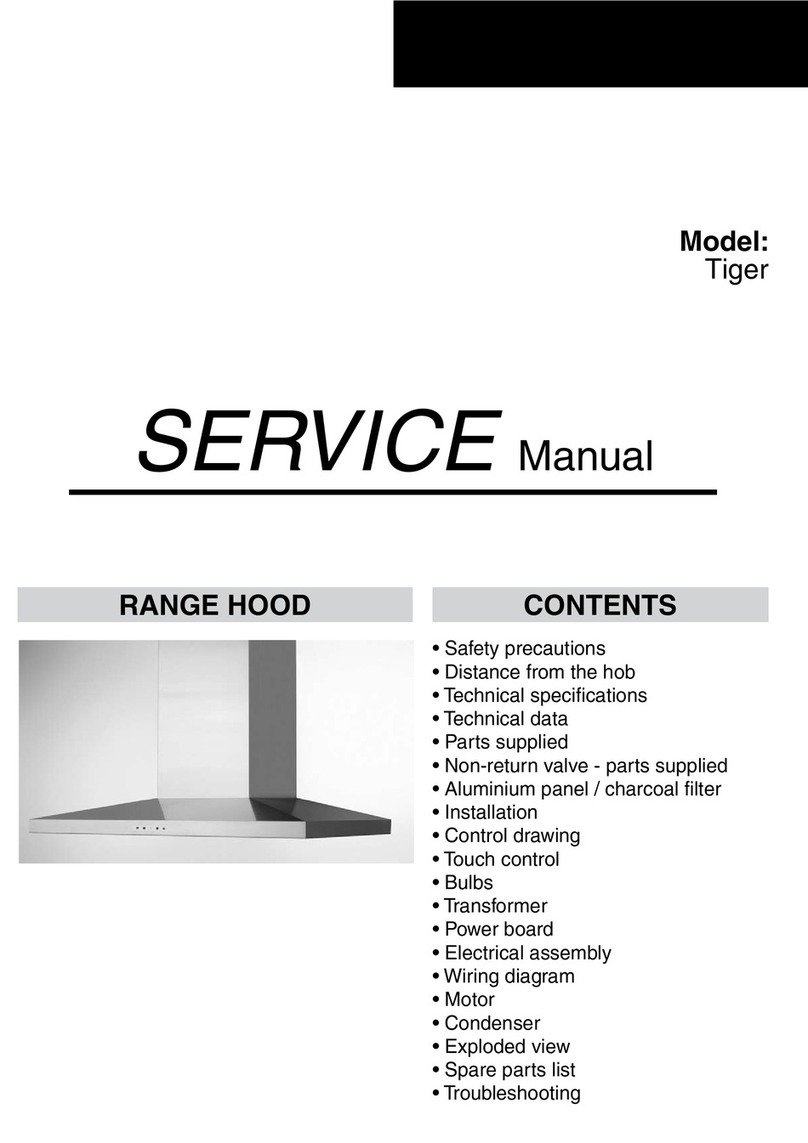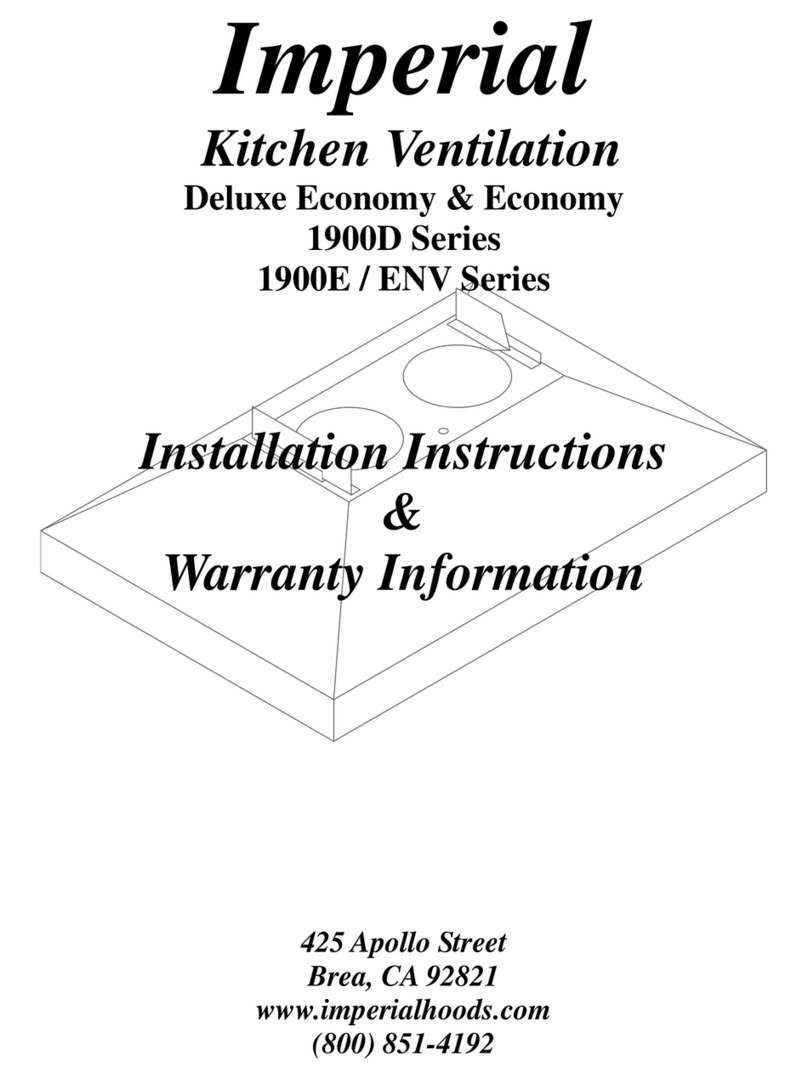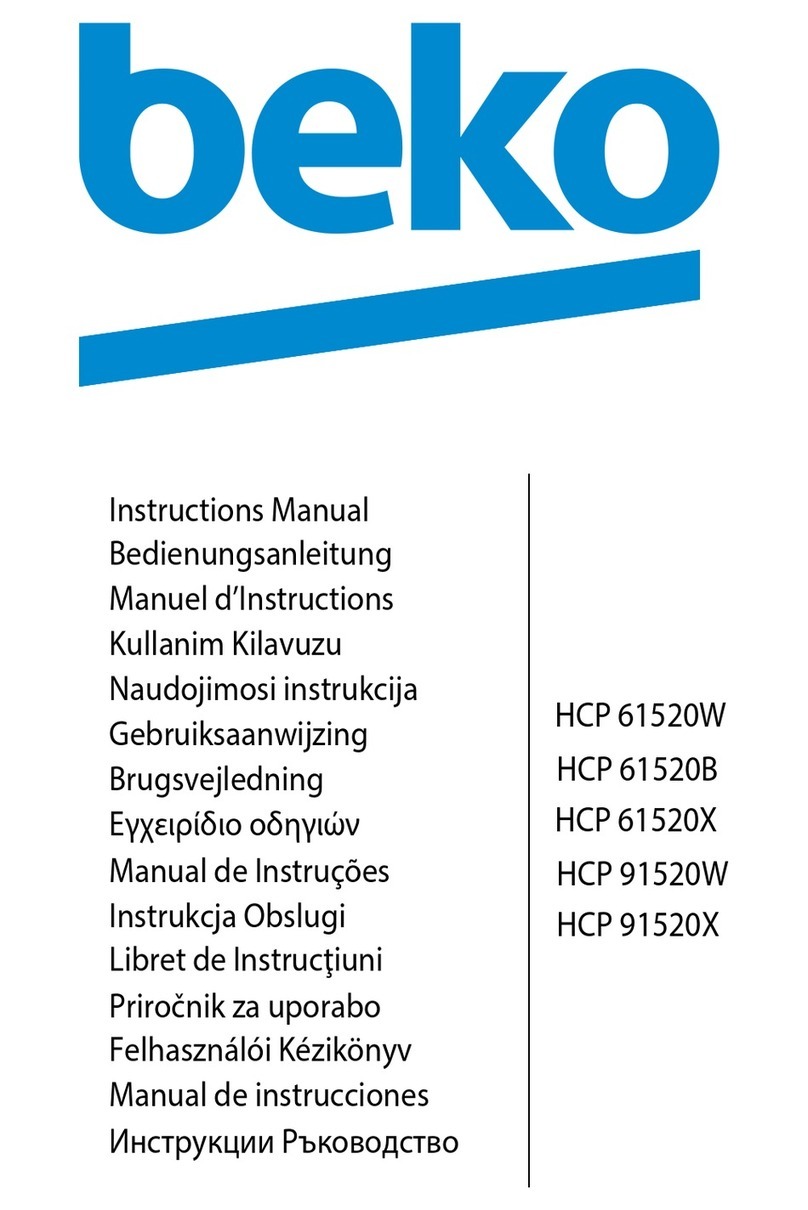Tecnowind EAGLE User manual

Model:
EAGLE
SERVICE Manual
RANGE HOOD CONTENTS
• Safety precautions
• Distance from the hob
• Technical specications
• Technical data
• Parts supplied
• Non-return valve - parts supplied
• Aluminium panel / charcoal lter
• Installation
• Control drawing
• Touch control
• Bulbs
• Transformer
• Power board
• Electrical assembly
• Motor
• Condenser
• Wiring diagram
• Exploded view
• Spare parts list
• Troubleshooting


SUMMARY
1. Safety precautions.....................................................................................................................................................................4
2. Distance from the hob.........................................................................................................................................................7
3. Technical specifications.........................................................................................................................................................8
4. Technical data............................................................................................................................................................................9
5. Parts supplied .......................................................................................................................................................................10
6. Non-return valve - parts supplied .....................................................................................................................................11
7. Aluminium panel / charcoal filter .......................................................................................................................................12
7.1 replacing the aluminum panel
7.2 replacing the charcoal filter
8. Installation...................................................................................................................................................13
8.1 fixing the appliance to a wall
8.2 fixing the decorative telescopic flue
8.3 installing the charcoal filters and aluminum panels
9. Control drawing......................................................................................................................................................................19
9.1 configuration
9.2 technical drawing of control board
10. Touch control............................................................................................................................................................................21
10.1 replacing the touch control
11. Bulbs.............................................................................................................................................................................................23
11.1 replacing the halogen bulbs
11.2 replacing the halogen bulbs socket
12. Transformer................................................................................................................................................................................26
12.1 replacing the transformer
13. Power board...............................................................................................................................................................................29
13.1 replacing the power board
14. Electrical assembly.................................................................................................................................................................31
15. Motor.............................................................................................................................................................................................32
15.1 replacing the motor
16. Condenser...................................................................................................................................................................................37
16.1 replacing the condenser
17. Wiring diagram.........................................................................................................................................................................40
18. Exploded view...........................................................................................................................................................................41
19. Spare parts list.....................................................................................................................................................................42
20. Troubleshooting.......................................................................................................................................................................43
- 3 -

Safety precautions
- 4 -
Before connecting the model to the electricity
network:
- Control the data plate (positioned inside the appliance)
to ascertain that the voltage and power correspond to
the network and the socket is suitable. If in doubt ask
a qualied electrician.
- If the power supply cable is damaged, it must be re-
placed with another cable or a special assembly, which
may be obtained direct from the manufacturer or from
the Technical Assistance Centre.
- This device must be connected to the supply network
through either a plug fused 3A or hardwired to a 2 fase
spur protected by 3A fuse.
WARNING !
In certain circumstances electrical appliances may
be a danger hazard.
A) Do not check the status of the filters while the
cooker hood is operating
B) Do not touch bulbs or adjacent areas, during or
straight after prolonged use of the lighting instal-
lation.
C) Flambè (Flamed) cooking is prohibited under-
neath the cooker hood
D) Avoid free flame, as it is damaging for the filters
and a fire hazard
E) Constantly check food frying to avoid that the
overheated oil may become a fire hazard
F) Disconnect the electrical plug prior to any main-
tenance.
G) This appliance is not intended for use by young
children or infirm persons without supervision
H) Young children should be supervised to ensure
they do not play with the appliance
I) There shall be adequate ventilation of the room
when the rangehood is used at the same time as
appliances burning gas or other fuels
L) There is a risk of fire if cleaning is not carried out
in accordance with the instructions
M) Please use a private plug receptacle for power
plug.
: It might set a fire.
N) Please don’t operate the hood when taking fire
on the dishes or frying pan.
: It might set a fire.
O) Please don’t touch the product or operate the
switch with wet hands.
: You might get a shock of electricity.
P) Please don’t wipe off the hood with the chemi-
cals when cleaning.
This appliance conforms to the European Directive
EC/2002/96, Waste Electrical and Electronic Equip-
ment (WEEE). By making sure that this appliance is
disposed of in a suitable manner, the user is helping
to prevent potential damage to the environment or to
public health.
The symbol on the product or on the accompa-
nying paperwork indicates that the appliance
should not be treated as domestic waste, but
should be delivered to a suitable electric and elec-
tronic appliance recycling collection point. Follow lo-
cal guidelines when disposing of waste. For more in-
formation on the treatment, re-use and recycling of
this product, please contact your local authority, do-
mestic waste collection service or the shop where the
appliance was purchased.
Assembly and electrical connections must be car-
ried out by specialised personnel.
• Electric Connection
The appliance has been manufactured as a class II,
therefore no earth cable is necessary.
The connection to the mains is carried out as follows:
BROWN = L line
BLUE = N neutral
If not provided, connect a plug for the electrical load
indicated on the description label. Where a plug is
provided, the cooker hood must be installed in order
that the plug is easily accessible. An omnipolar switch
with a minimum opening of 3mm between contacts,
in line with the electrical load and local standards,
must be placed between the appliance and the net-
work in the case of direct connection to the electrical
network.
Before proceeding with the assembly operations, re-
move the anti-grease filter(s) so that the unit is easier
to handle. In the case of assembly of the appliance in
the suction version prepare the hole for evacuation of
the air.
• We recommend the use of an air exhaust tube which
has the same diameter as the air exhaust outlet hole.
If a pipe with a smaller diameter is used, the efficiency
of the product may be reduced and its operation may
become noisier.

Safety precautions
- 5 -
• We recommend that the cooker hood is switched on
before any food is cooked. We also recommend that
the appliance is left running for 15 minutes after the
food is cooked, in order to thoroughly eliminate all
contaminated air.
The effective performance of the cooker hood de-
pends on constant maintenance; the anti-grease filter
and the active carbon filter both require special atten-
tion.
• The anti-grease filter is used to trap any grease parti-
cles suspended in the air, therefore is subject to satu-
ration (the time it takes for the filter to become satu-
rated depends on the way in which the appliance is
used).
-Topreventpotentialrehazards,theanti-grease lters
should be washed a minimum of every 2 months (it is
possible to use the dishwasher for this task).
-Afterafewwashes,thecolouroftheltersmaychange.
This does not mean they have to be replaced.
If the replacement and washing instructions are not fol-
lowed, the anti-grease lters may present a re hazard.
• The acrylic filter, which is found resting on the grille,
should be replaced when the text, visible through the
grille, changes colour and the ink spreads; the new fil-
ter should be fitted in such a way that the text can be
seen through the grille from outside the cooker hood.
• If the filters do not have any text on them, or if metal
filters or aluminium panel filters are used, they should
be washed every 2 months in order to prevent the risk
of fire.
To wash the filters, proceed as follows:
- Remove the filter from the grille and wash it using a
solution of water and neutral liquid detergent, leaving
the dirt to soften.
- Rinse thoroughly with warm water and leave to dry.
• The active carbon filters are used to purify the air
which is released back into the room. The filters are
not washable or re-usable and must be replaced at
least once every four months. The active carbon filter
saturation level depends on the frequency with which
the appliance is used, the type of cooking performed
and the regularity with which the anti-grease filters
are cleaned.
• Remove build-up from the fan and other surfaces
of the cooker hood regularly using a cloth moistened
with denatured alcohol or non-abrasive neutral liquid
detergent.
CAUTION!
Wear gloves during the installation of the product oth-
erwise injury at ngers could happen by sharp edges.

Safety precautions
WARNING !
• Take care when the cooker hood is operating simultaneously with an open fireplace or burner that depend
on the air in the environment and are supplied by other than electrical energy, as the cooker hood removes
the air from the environment which a burner or fireplace need for combustion. The negative pressure in the
environment must not exceed 4Pa (4x10-5 bar). Provide adequate ventilation in the environment for a safe
operation of the cooker hood. Follow the local laws applicable for external air evacuation.
- 6 -

Distance from the hob
• The minimum distance between the support surfaces of the cooking pots on the cooker top and the lowest part
of the cooker hood must be at least 650 mm.
If a connection tube composed of two parts is used, the upper part must be placed outside the lower part.
Do not connect the cooker hood exhaust to the same conductor used to circulate hot air or for evacuating fumes
from other appliances generated by other than an electrical source.
- 7 -

Technical specications
CONTROLS
ALUMINIUM PANELS
LIGHT
MODEL EAGLE
Size 600-900 mm
Finish St.steel A430
Motor JC2
Extracting power (m³/h) 500
Voltage 220-240V ~ 50/60Hz
Motor power consumption 1 x 130 W
Product certication CE - NEMKO
Product class II
Type model TYPE TOP..... MODEL:1J2HE
Air outlet diameter (mm) 150
Controls Touch Control
Speeds 3+1
Version Recycling
Filters Aluminium panels
Charcoal Filters 2 Circular lters
Bulbs 2 x 20 W Halogen lamps
Weight Gross 13,6 - 16 Kg
- 8 -
DUCTS

Technical data
- 9 -
motor power consumption 130 W
Speed Suction
(m³/h)
Pressure
(Pa)
Noise Level
(sound pressure)
dBA
Noise Level
(sound power)
dBA
1 172 135 34 44
2 279 213 44 54
3 380 257 52 62
4 500 286 57 67

Parts supplied
- 10 -
NON RETURN VALVE
MOUNTING SCREWS
AIR DEVIATOR
CHIMNEY BRACKET
2 CHARCOAL FILTERS
TYPE INSERT
3,2x13 self-tapping screw Pz 2
3,5x6 self-tapping screw Pz 2

Non-return valve
parts supplied
- 11 -
The non-return valve is recommended when the ap-
pliance is installed in the extracting version, to prevent
cold air blowing back in from outside.
The valve is made up of two parts which must be fixed
to the air outlet flange on the motor assembly
If the appliance is installed in the filtering version, the
non-return valve is not necessary.

- 12 -
Aluminium panel
Charcoal lter
The metal filters and/or aluminium panel are also dishwasher
safe. If the filters are made using aluminium, or if an aluminium
panel is used, after a few washes the colour may change. This
does not mean they have to be replaced.
If the replacement and washing instructions are not followed, the
anti-grease filters may present a fire hazard.
To replace the aluminium panels, simply operate the handle (a)
provided for the purpose, as illustrated in the drawing.
The active carbon filters are used to purify the air which is relea-
sed back into the room. The filters are not washable or re-usable
and must be replaced at least once every four months. The acti-
ve carbon filter saturation level depends on the frequency with
which the appliance is used, the type of cooking performed and
the regularity with which the anti-grease filters are cleaned.
To replace the active charcoal filters, simply operate the handle
provided for the purpose, as illustrated in the drawing.
Replacing the aluminium panel (a) 7.1
Replacing the charcoal lter (b) 7.2
a
b

- 13 -
Installation
Fixing the appliance to a wall 8.1
Phase 1
Phase 2
Before starting to fix the hood, disconnect the anti-grease
filter for easier appliance handing. Before this operation, perform
the following steps:
Phase 1
- Pull handle as shown in the picture and remove the anti-grease
filter.
Phase 2
- Check the distance between the surface which carries the co-
oking utensils on the cooking device and the bottom surface of
the cooker hood, which must be not less than 650 mm. Mark the
position of the lower side of the hood on the wall.
650 mm
CAUTION!
Wear gloves during the installation of the product otherwise injury at ngers could happen by sharp edges.

- 14 -
Installation
Phase 3
Phase 4
Phase 3
- Drill the holes A respecting the distances indicated. Fix the appli-
ance to the wall and align it in horizontal position to the wall units.
Phase 4
- When the appliance has been adjusted, definitely fix the hood
using the screws A. For the various installations use screws and
screw anchors suited to the type of wall (e.g. reinforced concrete,
plasterboard, etc.). If the screws and screw anchors are provided
with the product, check that they are suitable for the type of wall
on which the hood is to be fixed.
The hood is now fixed to the wall.

- 15 -
Fixing the decorative telescopic ue 8.2
Installation
Phase 2
Phase 1
- Arrange the electrical power supply within the dimensions of
the decorative ue. If your appliance is to be installed in the duct-
ing version or in the version with external motor, prepare the air
exhaust opening.
- Adjust the width of the support bracket of the upper ue.
- Then x it to the ceiling using the screws A in such a way that it is
in line with your hood and respecting the distance from the ceiling.
Phase 2
- Cut the air deviator D with a cutter, following carefully the first
pre-cut starting from the outer edge on both sides, as indicated
in the picture.
Air deviator D
Phase 1
A
B

- 16 -
Installation
D
C
C
D
Phase 3
- Take the air deviator D and make two holes as shown in the pho-
tographs.
- Secure the duct fixing bracket to the air deviator D as shown in
the photograph.
Phase 4
- Carry out final fixing of the air deflector D to the wall with a
fixing screw as shown in the photograph.
Phase 4
D
Phase 3
Ø 6

- 17 -
Phase 7
Phase 7
- Extend the upper decorative duct as far as bracket C and fix it in
place using screws X.
Installation
C
Phase 5
D
F
G
Phase 6
Phase 5
- Connect the flexible pipe (not supplied) to the deviator D.
- Fix the flexible pipe onto the connector flange G.
Phase 6
- Take care not to scratch the duct; wear gloves when removing
the protective lm.

- 18 -
Installation
Installing the charcoal lters and aluminum panels 8.3
Phase 1
Phase 2
Phase 1
- Take the active charcoal filters and position them in their hou-
sings.
Phase 2
- Take the aluminum panels and position them in their housings.

- 19 -
Control drawing
Conguration 9.1
A = on/o lights switch
B = on/o cooker hood switch
C = indicates the motor speed level selected
D = switches on the cooker hood. Increases the motor speed
E = timer

- 20 -
Control drawing
Technical drawing of control board 9.2
Table of contents
Other Tecnowind Ventilation Hood manuals
Popular Ventilation Hood manuals by other brands

Sirius Satellite Radio
Sirius Satellite Radio SLTC 111 Installation, Use and Maintenance Instruction

Whirlpool
Whirlpool HE36W Health & safety, use & care and installation guide
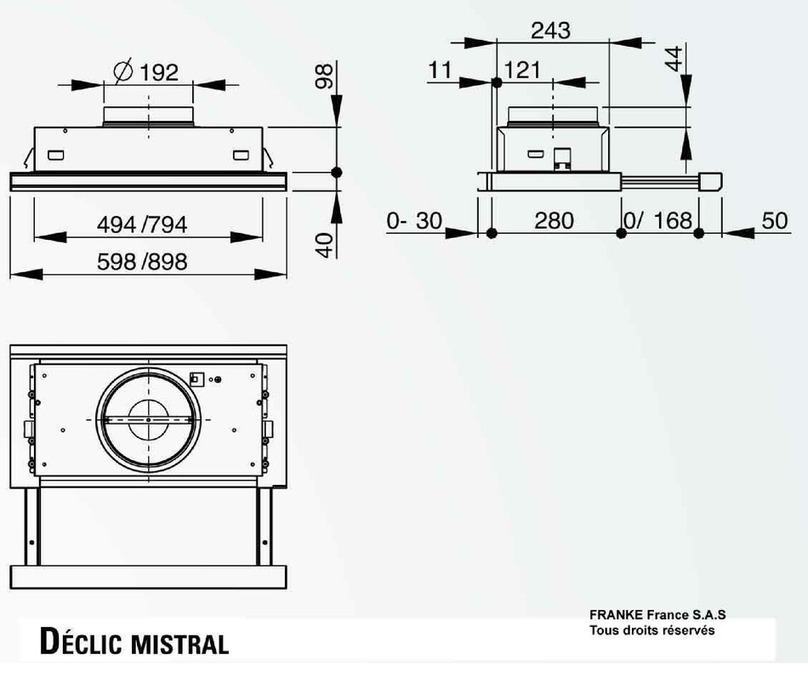
ROBLIN
ROBLIN DECLIC MISTRAL Dimensions
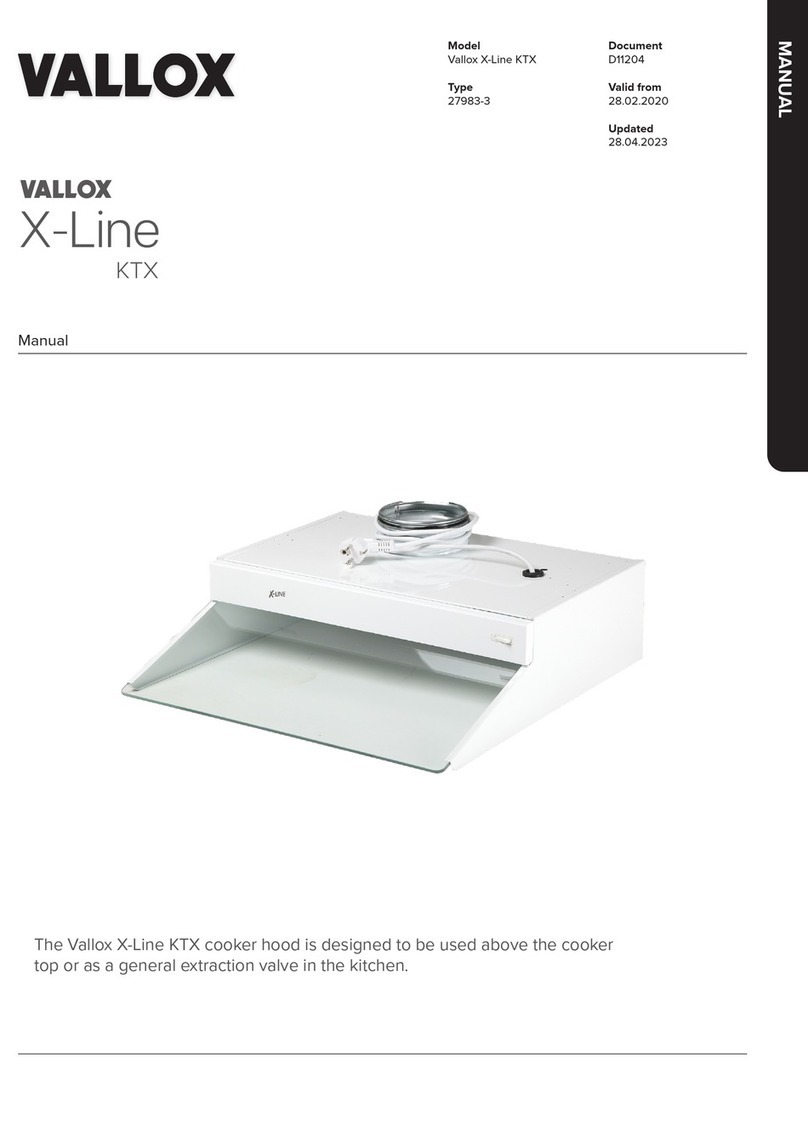
Vallox
Vallox X-Line KTX manual

FALMEC
FALMEC Lumen isola 175 Instruction booklet
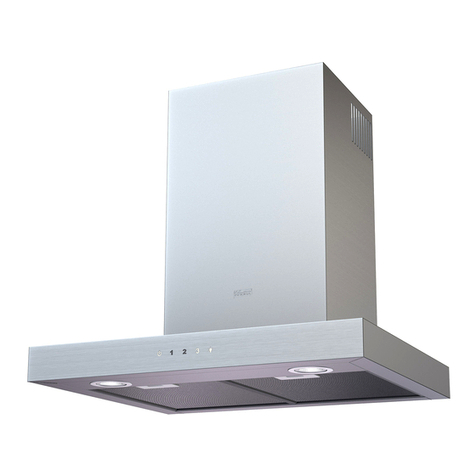
KRONAsteel
KRONAsteel RUT 600 inox 3P-S Application Sheet

Electrolux
Electrolux EFC 635 X user manual

Miele
Miele DA 5990 W EXT Installation diagram
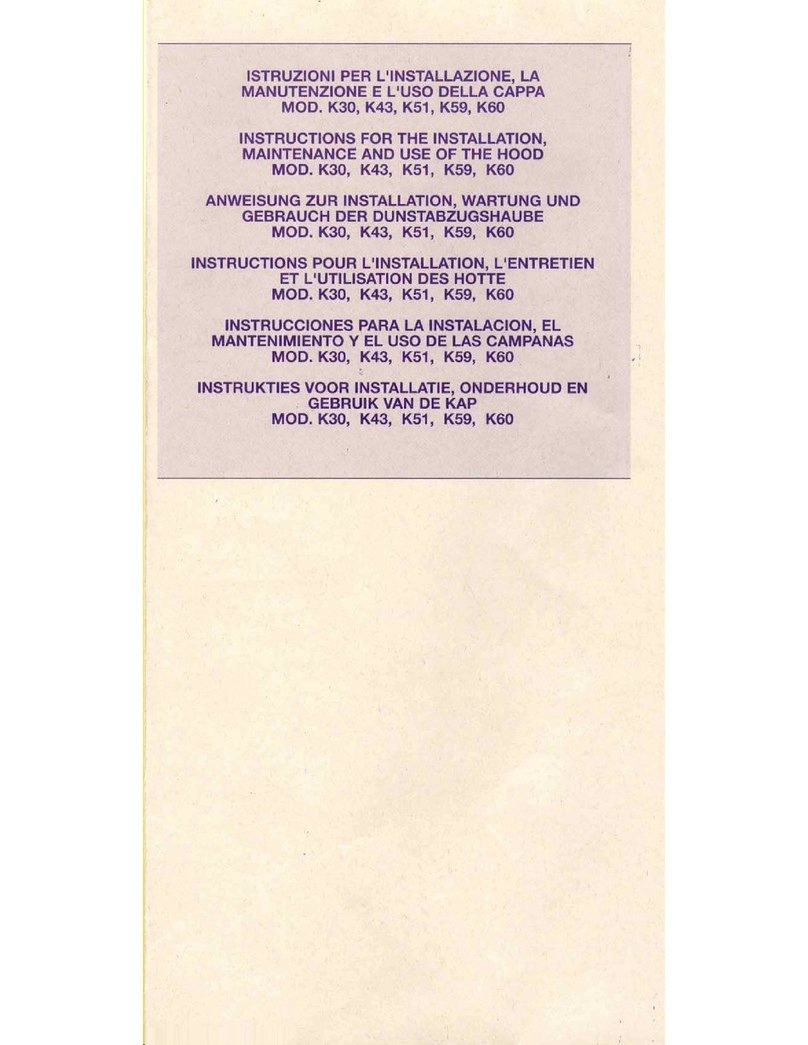
Baumatic
Baumatic BT120 Instructions for installation, use and maintenance

Lamona
Lamona LAM2877 user manual

Panasonic
Panasonic FV70HQU1 operating instructions

BKI
BKI Rotisserie Ventless Hood VGH-Series Installation and operation manual

